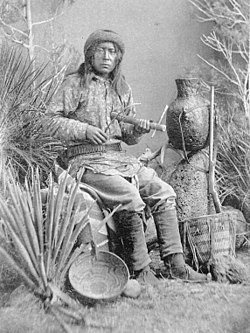Apache fiddle


The Apache fiddle (Apache: tsii' edo'a'tl, "wood that sings")[2] is a bowed string instrument used by the indigenous Apache people of the southwestern United States. The instrument consists of a plant stalk, such as that of the agave or mescal plant. One or sometimes two strings, often made of horse hair, are secured at both ends of the stalk, a bridge and nut added, and the string is played with a bow resined with pine pitch.[3] The string is touched with the fingers to change its note. The Smithsonian Institution holds an Apache fiddle collected in 1875.[4] In 1989 Apache fiddle maker Chesley Goseyun Wilson of Tucson, Arizona won a National Heritage Award.[5]
See also
[edit]References
[edit]- ^ "Portrait of Chasi, Bonito's Son..." National Anthropological Archives. (retrieved 11 June 2010)
- ^ Experimental Musical Instruments. Experimental Musical Instruments. 1995. p. 34.
- ^ Jadrnak, Jackie (1 August 2014). "Man wants to reintroduce the Apache fiddle, which has few makers remaining". Albuquerque Journal. Retrieved 24 October 2017.
- ^ American Indian art magazine Published by American Indian Art, Inc., 1980. Original from the University of Michigan. Digitized Dec 19, 2007. Page 28.
- ^ 1989 NEA National Heritage Fellow: Chesley Goseyun Wilson Archived 2008-10-05 at the Wayback Machine, National Endowment for the Arts (USA)
Sources
[edit]- Native American Stringed Musical Instruments by Daniel Brinton. in The American antiquarian and oriental journal By Stephen Denison Peet Jameson & Morse, 1897 v. 19, pg 20.
- The Apache Violin: Indigenous violin music in South and North America Archived 2016-03-04 at the Wayback Machine Jon Rose Web, 2005


 French
French Deutsch
Deutsch